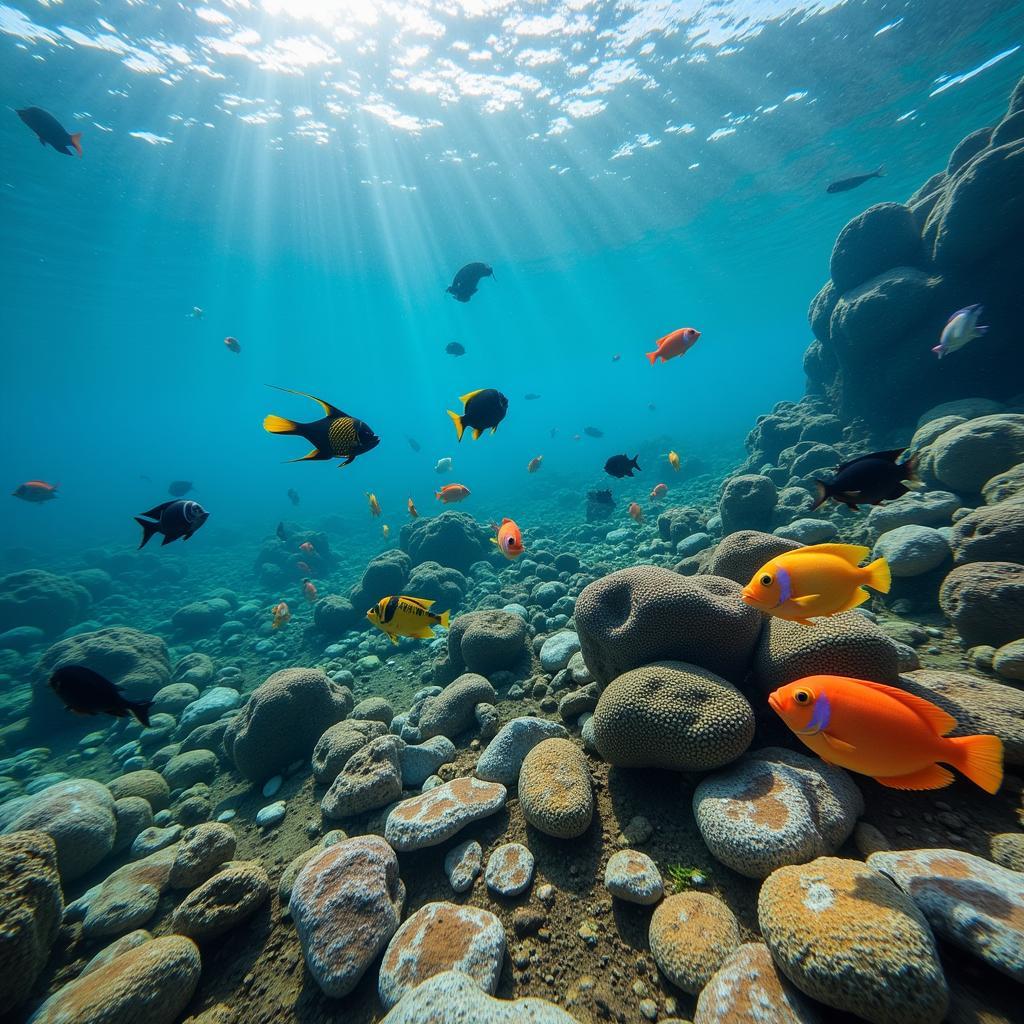A Colorful Dive into African Cichlid Species
African cichlids are some of the most popular aquarium fish in the world, known for their vibrant colors and fascinating behaviors. Originating from the freshwater lakes of Africa, these fish boast incredible diversity, with estimates reaching over 2,000 different African Cichlid Species, many yet to be scientifically described. Their beauty, however, is matched by their complex needs, making them a challenging yet rewarding group of fish for aquarium enthusiasts to keep.
A World of Diversity in African Lakes
 African Cichlids in Lake Malawi
African Cichlids in Lake Malawi
The Great Lakes of Africa, namely Lake Victoria, Lake Malawi, and Lake Tanganyika, are hotspots for cichlid evolution. Each lake houses a unique collection of cichlids, each species adapted to specific ecological niches within the lake. This incredible diversity is a result of adaptive radiation, a process where a single ancestor species evolves into multiple species, each with distinct traits suited to different environments and food sources.
For instance, some african cichlid species have evolved specialized mouthparts perfectly designed to graze on algae growing on rocks, while others have developed elongated jaws for snatching small invertebrates from crevices. This diversity extends beyond their physical adaptations, encompassing a vast range of behaviors, breeding strategies, and social interactions.
Identifying African Cichlid Species: A Visual Guide
Identifying specific african cichlid species can be a rewarding challenge, even for experienced aquarists. While their vibrant colors might seem like the most obvious clue, relying solely on coloration can be misleading, as many species display significant variations based on factors like age, sex, and even mood. To accurately identify an African cichlid, a combination of characteristics must be considered:
- Body Shape: Cichlids from different lakes often exhibit distinct body shapes. For example, many Lake Tanganyika cichlids have elongated, torpedo-like bodies adapted for open water swimming, while some Lake Malawi species have deeper, more compressed bodies suited for maneuvering among rocks.
- Fins: Fin shape and size can also offer valuable clues. Some species, like the “featherfin” cichlids, possess elongated fin rays, while others, such as the “peacock” cichlids, are known for their large, flowing dorsal fins.
- Markings and Patterns: While color can be variable, specific markings, like bars, spots, or stripes, are often consistent within a species and can aid in identification.
- Behavior: Observing the fish’s behavior can provide further hints about its species. Some cichlids are highly territorial and aggressive, while others are relatively peaceful and social. Their feeding habits, swimming patterns, and interactions with other fish can all contribute to identification.
If you’re unsure about the identity of your African cichlid, resources like the african cichlid species identification guide can be incredibly helpful.
Setting Up Your African Cichlid Aquarium
Creating a thriving habitat for your African cichlids is crucial for their well-being. Due to their active nature and often territorial behavior, a spacious tank is essential. A tank size of at least 55 gallons is recommended for most species, with larger tanks required for larger or more aggressive cichlids.
- Water Quality: African cichlids thrive in hard, alkaline water with a pH between 7.8 and 8.5. Regular water changes and the use of a high-quality filtration system are crucial for maintaining optimal water parameters and preventing the buildup of harmful toxins.
- Substrate: A sandy substrate is ideal for African cichlids, mimicking their natural environment. Avoid using gravel that is small enough to be swallowed, as this can cause digestive issues.
- Decorations: Rocks, caves, and driftwood can be used to create a naturalistic environment with plenty of hiding places. This is especially important for breaking up lines of sight and reducing aggression between territorial individuals.
- Plants: While live plants can enhance the aesthetics of your aquarium, not all plants are suitable for African cichlids. Many species are herbivores and may graze on delicate plants. If you choose to include plants, opt for hardy, fast-growing varieties.
For a comprehensive list of suitable African cichlid species for your aquarium, you can explore our african cichlids species list.
The Allure of African Cichlids
“African cichlids are a living testament to the power of evolution,” says Dr. Edward Nkolo, a renowned ichthyologist specializing in African cichlids. “Their incredible diversity, both in appearance and behavior, makes them a constant source of fascination for scientists and aquarists alike.”
Keeping African cichlids is a rewarding experience for hobbyists who appreciate their vibrant colors, engaging behaviors, and the unique challenges they present. By understanding their needs and replicating their natural environment as closely as possible, you can create a thriving underwater world that showcases the beauty and wonder of these remarkable fish.
Frequently Asked Questions about African Cichlids
1. What do African cichlids eat?
African cichlids have varied diets depending on their species. Some are herbivores, feeding primarily on algae and plant matter, while others are carnivores, preferring insects, crustaceans, and even smaller fish. A balanced diet tailored to the specific dietary needs of your chosen species is essential for their health and well-being.
2. How long do African cichlids live?
With proper care, African cichlids can live for a surprisingly long time for aquarium fish. Many species have a lifespan of 5 to 10 years, with some individuals even exceeding this range.
3. Are African cichlids aggressive?
Some African cichlid species are known for their territorial and aggressive behavior, especially during breeding. However, not all cichlids are equally aggressive. There are many peaceful and community-friendly species available, making it essential to research and select compatible tank mates.
4. Can I keep African cichlids with other types of fish?
While it is possible to keep certain African cichlids with other fish species, careful consideration is needed. Tank mates should be chosen based on their compatibility with cichlids in terms of water parameters, temperament, and adult size.
5. How can I tell if my African cichlids are breeding?
Breeding behavior in African cichlids can be fascinating to observe. Signs of breeding include increased aggression, digging in the substrate, and most notably, mouthbrooding, where the female incubates the eggs and fry in her mouth.
For more information on specific types of African cichlids, you can explore our articles on african cichlid hap species and the vibrant african fire jewel cichlid.
If you’re considering adding African cichlids to your aquarium, remember to conduct thorough research and choose species that align with your experience level and aquarium setup. With proper care and attention, these captivating fish can bring a splash of color and fascinating behaviors to your home aquarium, providing you with years of enjoyment.
Need help with your African cichlids? Contact us!
Phone: +255768904061
Email: kaka.mag@gmail.com
Address: Mbarali DC Mawindi, Kangaga, Tanzania.
We have a dedicated customer support team available 24/7.




